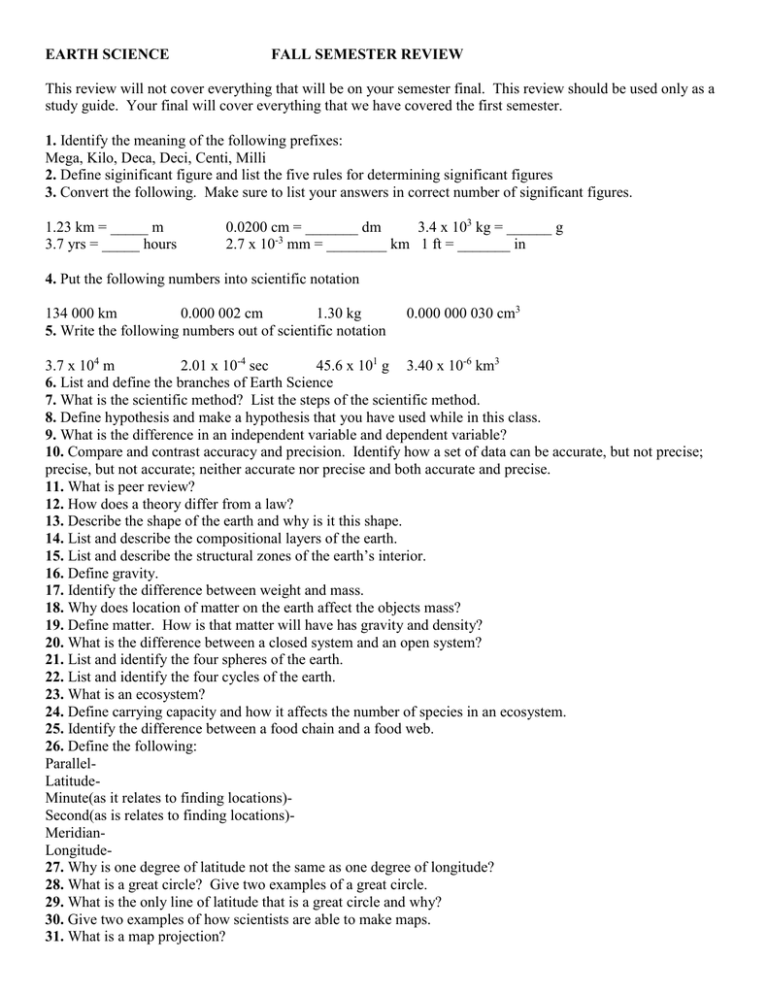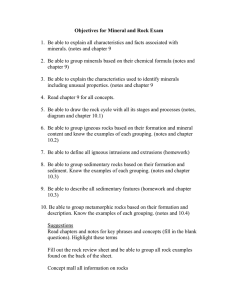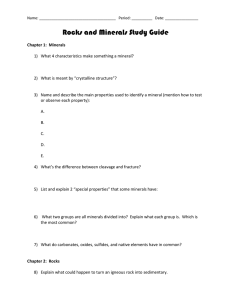Fall Semester Review
advertisement

EARTH SCIENCE FALL SEMESTER REVIEW This review will not cover everything that will be on your semester final. This review should be used only as a study guide. Your final will cover everything that we have covered the first semester. 1. Identify the meaning of the following prefixes: Mega, Kilo, Deca, Deci, Centi, Milli 2. Define siginificant figure and list the five rules for determining significant figures 3. Convert the following. Make sure to list your answers in correct number of significant figures. 1.23 km = _____ m 3.7 yrs = _____ hours 0.0200 cm = _______ dm 3.4 x 103 kg = ______ g -3 2.7 x 10 mm = ________ km 1 ft = _______ in 4. Put the following numbers into scientific notation 134 000 km 0.000 002 cm 1.30 kg 5. Write the following numbers out of scientific notation 0.000 000 030 cm3 3.7 x 104 m 2.01 x 10-4 sec 45.6 x 101 g 3.40 x 10-6 km3 6. List and define the branches of Earth Science 7. What is the scientific method? List the steps of the scientific method. 8. Define hypothesis and make a hypothesis that you have used while in this class. 9. What is the difference in an independent variable and dependent variable? 10. Compare and contrast accuracy and precision. Identify how a set of data can be accurate, but not precise; precise, but not accurate; neither accurate nor precise and both accurate and precise. 11. What is peer review? 12. How does a theory differ from a law? 13. Describe the shape of the earth and why is it this shape. 14. List and describe the compositional layers of the earth. 15. List and describe the structural zones of the earth’s interior. 16. Define gravity. 17. Identify the difference between weight and mass. 18. Why does location of matter on the earth affect the objects mass? 19. Define matter. How is that matter will have has gravity and density? 20. What is the difference between a closed system and an open system? 21. List and identify the four spheres of the earth. 22. List and identify the four cycles of the earth. 23. What is an ecosystem? 24. Define carrying capacity and how it affects the number of species in an ecosystem. 25. Identify the difference between a food chain and a food web. 26. Define the following: ParallelLatitudeMinute(as it relates to finding locations)Second(as is relates to finding locations)MeridianLongitude27. Why is one degree of latitude not the same as one degree of longitude? 28. What is a great circle? Give two examples of a great circle. 29. What is the only line of latitude that is a great circle and why? 30. Give two examples of how scientists are able to make maps. 31. What is a map projection? 32. List three types of map projections and how these map projections are produced. 33. What is a scale? List and define the three types of scales that can be used on a map. 34. Define the following. TopographyElevationContour linesRelief35. Identify three types of maps. Explain what these maps are used for and what information they provide. 36. Compare chemical properties and physical properties. Give examples of each. 37. Describe the basic structure of an atom. 38. Compare atomic number, mass number and atomic mass. 39. Define isotope. 40. Describe the arrangement of elements on the periodic table. What are the three most abundant elements in the composition of the earth? Make sure to list the percentage of each. 41. List the three subatomic particles. Identify their charge and location. 42. What are valence shell electrons and why are they important? 43. Define compound and molecule. 44. Interpret chemical formulas. 45. Describe two ways that electrons form chemical bonds between atoms. 46. Explain the difference between compounds and mixtures. 47. What is a chemical equation and give an example? (page 88) 48. What is the only thing that can be applied to a chemical equation to balance the equation? 49. Identify the difference between an ionic bond and a covalent bond. 50. What is a mixture? Describe the difference between a homogeneous and a heterogeneous mixture. 51. Define mineral. 52. Compare the two main groups of minerals. 53. Identify the six types of silicate crystalline structures. 54. Describe the common nonsilicate structures. 55. Identify the four questions that must be asked to identify a mineral. 56. Identify and define the 7 physical properties of minerals. 57. Compare and contrast cleavage and fracture. 58. Identify and define the 5 special properties of minerals. 59. Summarize three factors that affect melting of rocks. 60. Identify and define the three rock types. 61. Compare and contrast the three types of sedimentary rock. 62. Compare and contrast partial melting and fractional crystallization. 63. What is chemical stability of rocks and what affects it? 64. Identify and define seven sedimentary rock features. 66. Summarize the steps in the rock cycle. 67. Explain Bowen’s reaction series. 68. Describe how the cooling rate of magma and lava affects the texture of igneous rock. 69. Classify igneous rock according to their composition and texture. 70. Describe intrusive and extrusive igneous rock structures. Give three examples of each. 71. Define mafic and felsic and how do they differ. 72. Explain the processes of compaction and cementation. 73. Describe how chemical and organic sedimentary rocks form. 74. Describe how clastic sedimentary rock forms. 75. Describe the processes of metamorphism. 76. Explain the difference between regional and contact metamorphism. 77. Distinguish between foliated and nonfoliated metamorphic rocks and give an example of each. 78. Describe how the distance sediment travels affects its size and shape.






